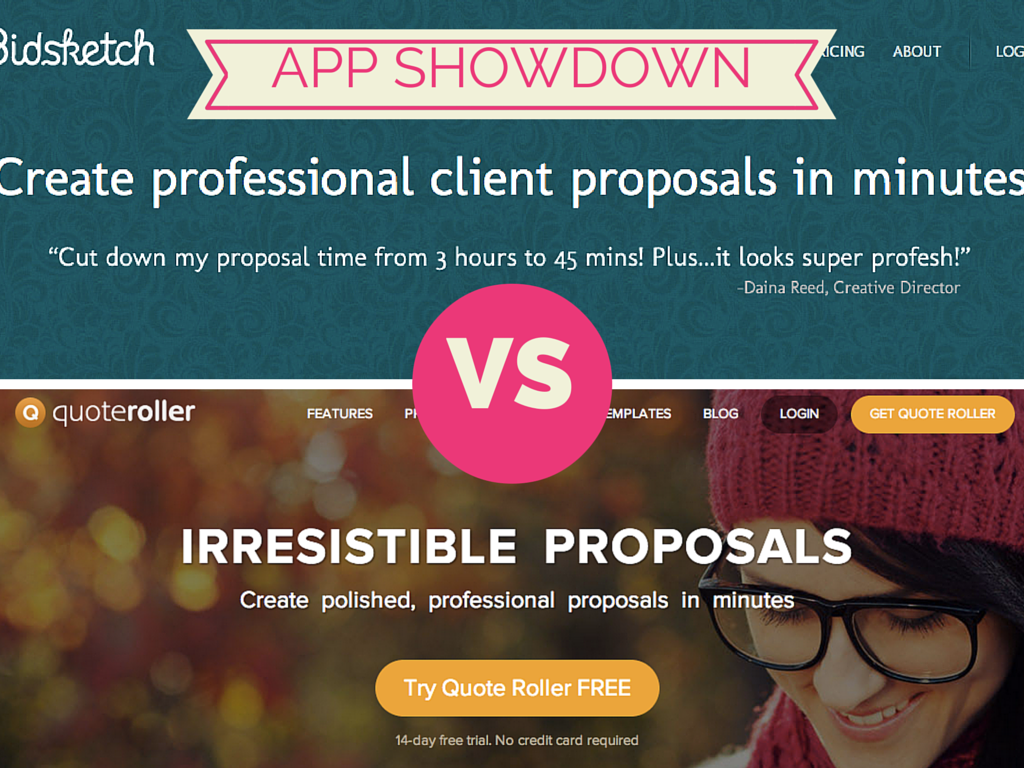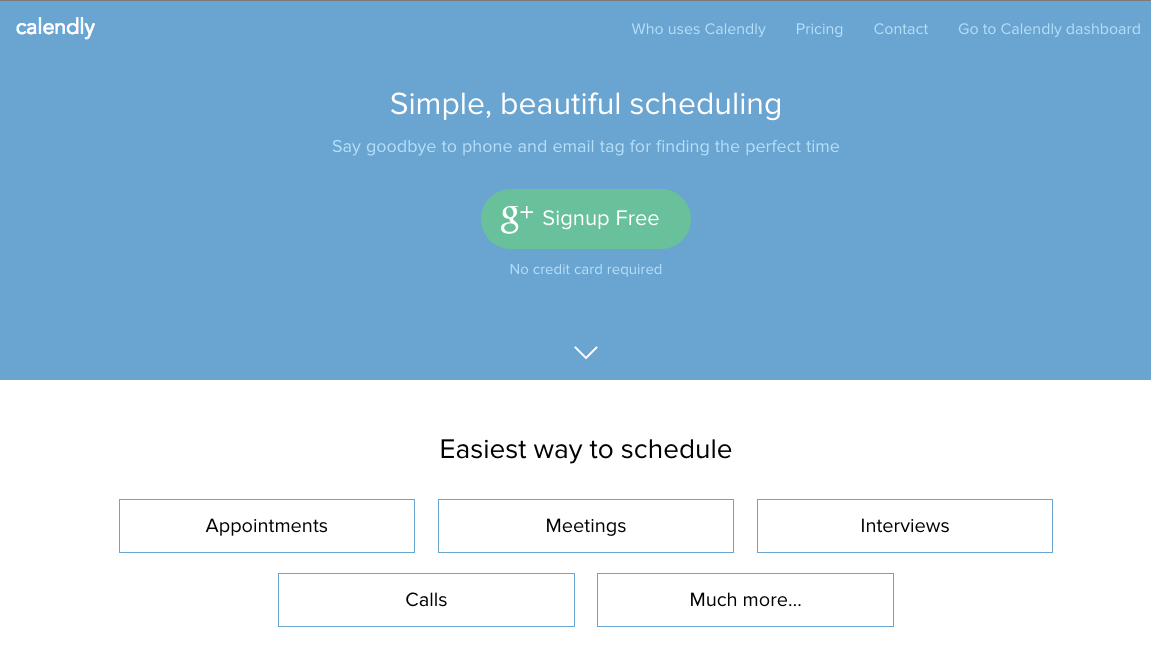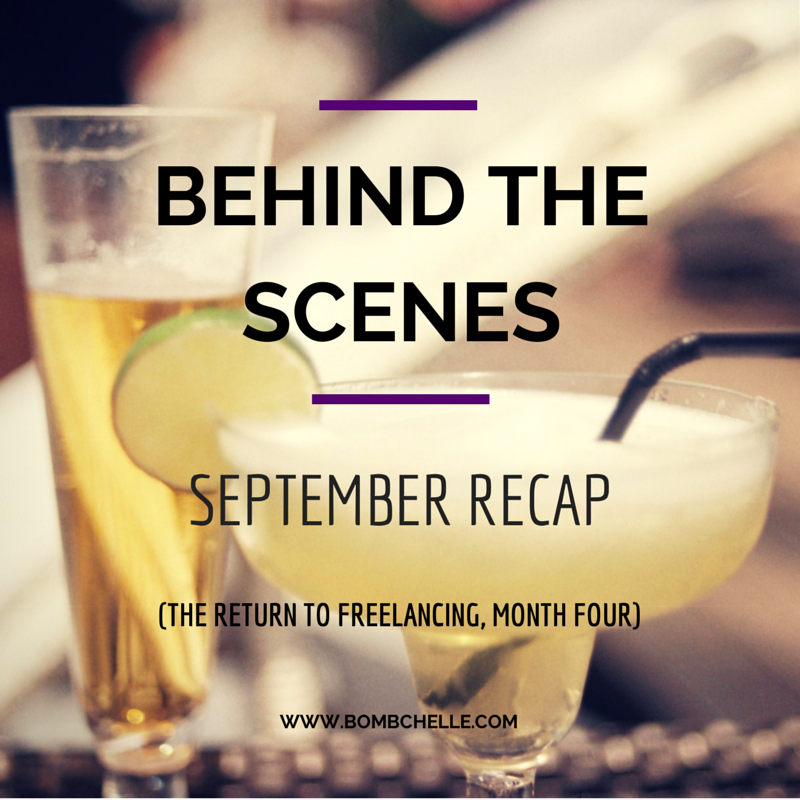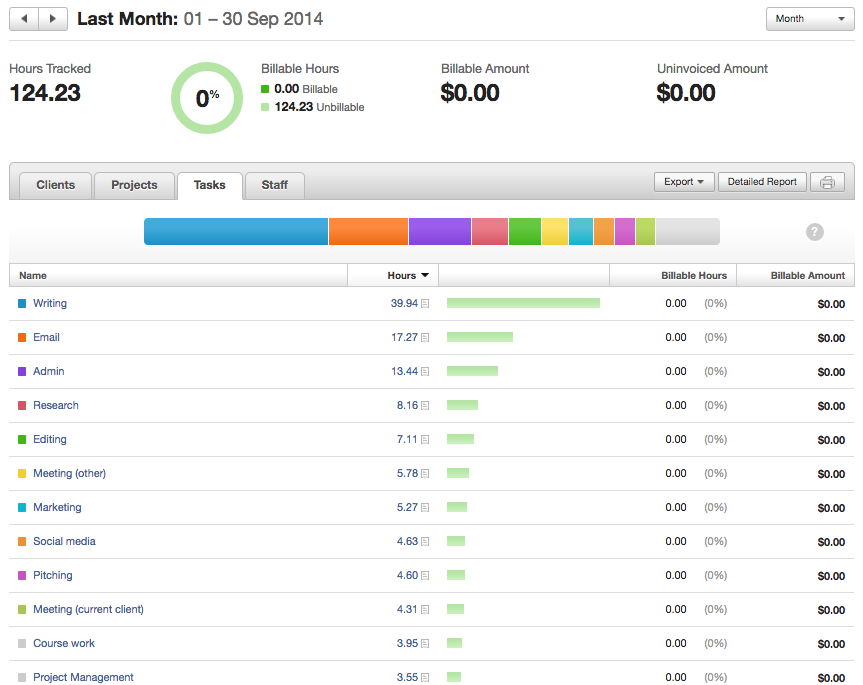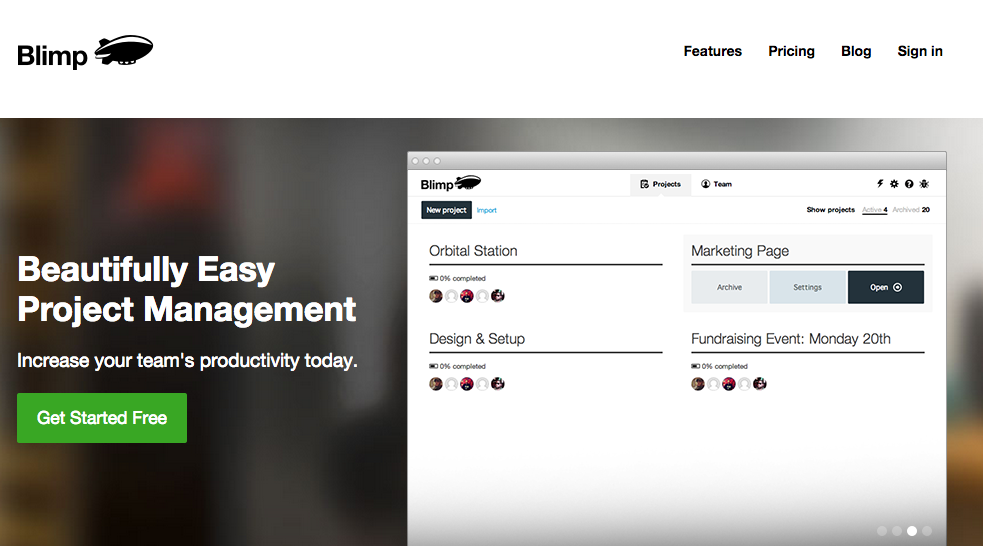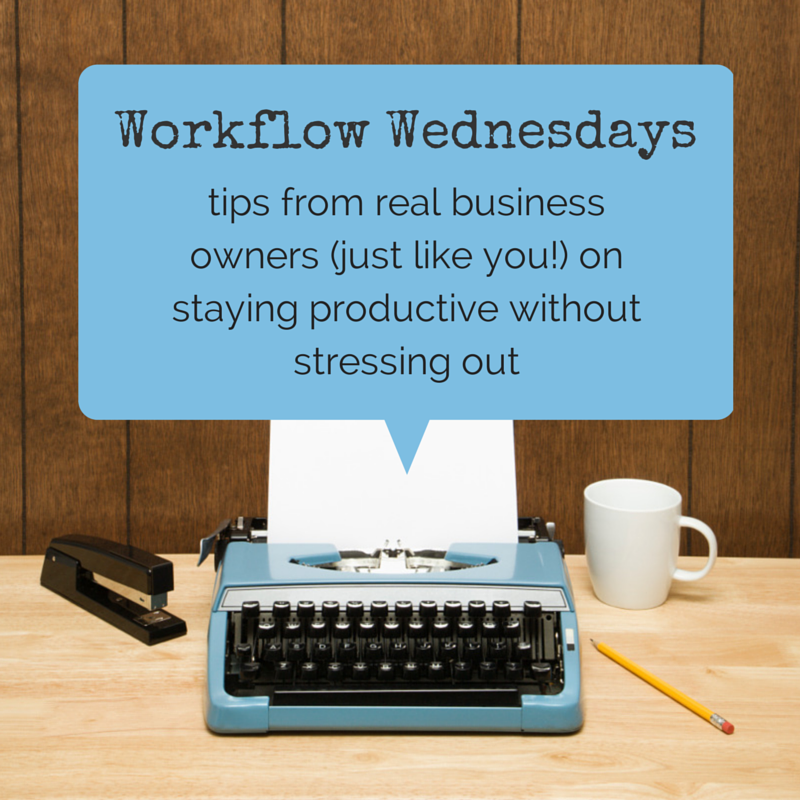
What separates productive people from business owners that are constantly stressed? This post is part of weekly feature, Workflow Wednesdays, that aims to find out, with a weekly post going in-depth on a specific part of a business owner’s workflow and what they do that makes it rock. Interested in being featured in a post? Sign up here!
This week, I’m talking to Martin Stellar, a monk-turned-tailor-turned-copywriter-turned-teacher (say that three times fast!). In our interview, we talk about why NaNoWriMo works, why you keep getting stuck in your writing, and Martin reveals his “thumbtack hack” that’ll make you a better writer. Curious? Listen in:
The transcript is at the bottom of the post, and here’s the show notes:
Martin’s four tips for writing faster (and thus, writing more):
- Don’t use spellcheck
- Don’t backspace
- Don’t stop
- Write every day
Useful apps to help you implement what we talked about:
- If you want to get into the habit of writing every day, 750Words can help–it gives you a minimalist space to work, tracks your writing streaks, and sends you reminder emails to keep you motivated.
- If you’re not necessarily into the thumbtack idea (for whatever reason 😉 ), you can use the typewriter mode with Write or Die to train yourself not to backspace or edit while writing.
- If you want an easy way to keep track of your ideas on the go, but are more digital than analog (and don’t feel like carrying around a notebook), installing Evernote on your phone can let you have constant access to an idea file, that you can then access on your computer (or through the Evernote site) when it’s time to write.
Resources mentioned on the show:
People tend to be starkly divided on the topic of listening to music while working. The science itself is even conflicted, with one researcher saying that music improves productivity because it puts you in a better mood while working and several other articles I found saying that music can actually downgrade productivity for cognitively-draining tasks.
This article gives a breakdown of what tasks music works with/against, although the writer concludes that lyrics-based music is awful for writing or other language based tasks. (They also suggest video game soundtracks, which I’m personally quite fond of–Chrono Cross OST for the win!) Music with lyrics works for me, although I typically steer away from lyrics that I don’t know or super-lyrics-driven music.
Any questions? Hit us up in the comments or on Twitter! (I’m @_chelleshock and he’s @martinstellar.) And if you want to be the next Workflow Wednesday interviewee, head your pretty lil face over here to sign up.
The interview transcript:
(You can also download it as a PDF, if you like.)
Michelle: Hi guys, this is Michelle Nickolaisen with Bombchelle.com, and this is another interview in the Workflow Wednesday series. Today, we are interviewing Martin Stellar, who is a monk turned copywriter. Actually, monk turned tailor turned copywriter, among other things, and he’s going to give us some tips on improving your writing workflow. So Martin, for those who are new to you, can you give us a quick introduction into your background and how you came to be doing what you’re doing now?
Martin: It’s mostly like you said. I was a monk for twelve years, or six years as a monk while twelve years in a monastery. I became a tailor there and made fancy suits by hand. When I left there, I decided to start my own company, and it didn’t really go so well. It lasted a few years, but because I didn’t do any marketing other than some blogging and in the end, I just couldn’t keep it up. At that point, I decided to move to a bigger city, Marbella, where there’s more wealthy people, and to keep paying the bills, I started writing some articles, because I’d always been able to write, and I discovered that I actually liked the work of article writing. Somebody said at some point do you do sales copy as well, so I took on that job, and discovered that sales copy can be profitable, I can do it as well. And then I decided to spend a number of years without any tailoring whatsoever, just doing the copywriting. That, at some point, started to get me down because I had trouble finding the right kind of clients. There were many people trying to break out of cubicle nation who didn’t understand how to use the tool when they wrote copy, so they would send the wrong kind of traffic at it, or they would go and edit the copy. I’m sure you’ve had that experience as well.
Michelle: Mm-hmm. [laughs]
Martin: Which usually means breaking the copy.
Michelle: Yeah.
Martin: Yeah. So earlier this year, I came into a situation where I was wondering about new direction, and I realized instead of selling people the tool, why not teach people how to use the tool? Meaning teach people how to be in business, how to put all the things together, what the site is for, and how to relate with your customers, because over the years, and this is partly, too, because of many years of meditation, I’d become good at understanding psychology, and business and sales are made of psychology. It’s what makes a sale happen. It’s understanding the other person, being able to relate to them, and understanding their frustration, their pains, their fears. So that’s what I started in May. A monthly newsletter, which is a pretty long issue that I write, teaching the ins and outs of how to be in business in a profitable way, and added to that is a mentorship program where I teach people how to do email writing. So they learn how to write a daily email that people actually enjoy reading and buying from.
Michelle: Yeah. Yeah, that’s great, and it reminds me … your trajectory kind of actually reminds me of a friend of mine, Shenee Howard, and she started doing out design and sometimes doing copywriting, but what she discovered was that a lot of times, it was kind of like you mentioned with the copywriting, is that like a lot of times, it’s just kind of glossed. It’s like putting a shiny coat of paint on something that’s not necessarily working if they don’t understand…if they don’t understand what they’re actually selling or the pain points of their customers or why people are buying. Things like that. Good design isn’t going to save your business if that’s the case.
Martin: No.
Michelle: So it’s kind of a similar thing, right?
Martin: Yes, quite. To me, it’s really a tool. Copy is not going to save your business, no matter how good it is written, and if you don’t know how to use that tool, you can take a hammer and try to drive a screw into the wall. It’s not really going to work. You need a screwdriver for that.
Michelle: Yeah.
Martin: So that’s what I observed with a lot of clients, that they felt that good copy was going to be the saving grace. Like I had one client starting a telephone midwife service, because in the UK, the National Health Service doesn’t have enough time for you, and expectant mothers were suffering the consequences of midwifes who just didn’t have the time. So they figured we’re going to start a telephone midwife service which goes along with the NHS midwifery, which is great, you know? You can book an appointment. This lady will have all the time that you need. They can even come and visit. It’s a fantastic program. But they came at it with the idea that, well, we’re going to do a proof of concept, we’re going to drive a whole bunch of traffic at it, and see if it works, if it converts. And the way they built the website with the copy that I wrote for them, they sent all the traffic from ads to a sales page. But look, if you’re about to give birth, you want to trust the person who is going to be giving you the advice, and if you click on an add, and it’s going to say this is 300 pounds and then you get your midwife, that’s not enough to have somebody trust that you actually know your stuff. You need to start by signing them up to a list, then you start a communication process with daily emails or weekly emails showing them that yeah, you know your stuff. That you can be trusted. That you can rely on this person on the other side of the phone. You don’t just send ad traffic to a sales page for something that difficult.
Michelle: Yeah, yeah. Definitely. I think that’s a lesson that a lot of business owners need to learn.
Martin: Yeah.
Michelle: One of the things that I think is interesting is that I feel like people don’t necessarily effectively outsource, and I think that this is why some service providers end up teaching as well. People can’t really effectively outsource something, and design is one thing because it requires a whole specialized set of software as well as skills, but with something like writing, I feel like people can’t really outsource it until they’ve done it to some level of effectiveness themselves, because otherwise, they aren’t going to be able to give the person the direction that they need, and so I think that’s probably why what you’re talking about is such a valuable service, because even if people who learn from you wind out outsourcing later, they’re going to be so much better equipped to give the writer what they need.
Martin: Of course. Yes, absolutely.
Michelle: So as far as the stuff that you teach people, I know that one of the things that you talk about is the speed of writing. Can you talk about why you put a focus on writing faster, and maybe from there, we can talk about some of the ways that you teach people to write faster?
Martin: Mm-hmm. The faster you write, the better you get at it, basically. You see, people come at writing, most people that I work with, from a very rational, intellectual point-of-view, that it has to be quality and you have to sit there and create something that people are going to like, and that’s counter to the process of writing, which is very intuitive, emotional, creative process. You can’t really let your mind be involved. Not in the first stage, right? I like to think of it in terms of three writer’s hats. You’ve got the visionary who comes up with the idea. That’s the guy who says, you know, you’re driving down the road, and suddenly an idea, pull over and write this down. “This is fantastic. I’m going to write about this later.” That’s your visionary, that’s the first one.
Then your second persona is the actual writer, and that’s the creative, non-rational person. The one who takes the idea that the visionary gives him, and blurts out 500, 1000, 1500 words, preferably as fast as possible and as ugly as possible. That first draft should be fast and it should be ghastly. It should be shitty. It should be terrible, because if you write without judging the way you’re writing and the quality of it, you let your creativity flow unfettered, and then you end up with a long piece, and you look at it, and you think, “Man, that’s a mess. What am I going to do with this?”
That’s when you call your third persona. That’s the editor. That’s the rational guy. He comes and looks at that piece that the writer created and he rubs his hands and he’s like, “Let’s make something out of this. There is gold in here.” And he’ll probably delete 30-50% of what the writer created, but what’s left in that reformatted and edited way that the editor goes about it, it becomes a good piece. And the worst thing that a writer can do, whether it’s an email that you’re writing or sales copy or a blog post or a guest post is to have that editor looking over your shoulder and saying, “No, no, no, you’ve got to go back there. There’s a typo there, and that’s a wrong spelling, and the grammar is broken.” So you’re constantly backspacing going into edit something. That action, when the mind comes in, that stalls the creative flow, so if you can train yourself to not go back and continue writing even if the stuff is bad, you become much faster at it, and you make life much easier for your editor as well.
Michelle: Yeah. Yeah. And it reminds me…so, I had this discussion. I’m doing NaNoWriMo right now, which for those who don’t know, NaNoWriMo is National Novel Writing Month, and the goal is to write. There are a couple different variations on it. There are people doing blog post challenges and things like that. But the idea is that you write 50,000 words during the month of November. And I think technically, you’re not supposed to start until November 1st, but I’m using it to get the first draft done of a book that I’m working on that I had started before November. My goal is to write 50,000 words on that book in November. Last weekend, I had did a couple writing dates with my boyfriend because he’s also a writer, but he’s also an editor. Like, he writes, but editing is something that he really, really loves, and he’s really into editing. He’s also really into writing, but I’m definitely a writer first and foremost. I’ll edit things for some people sometimes, but I would much rather honestly pay someone else to edit my stuff than go back in and do it myself. I’m one of those writers that definitely needs an editor. And so we worked. I was talking with Chris, and it was at the end of the day on Sunday, and I did like, I think about almost 9000 words in between Saturday and Sunday last weekend, and he was just like, “Oh, man, I can’t even imagine.” And I was like, “Well, yeah, because you’re an editor.” Like, because the urge to go back and fix things must be so much worse.
Martin: That’s perfect proof of what I’m saying. That if you’re in the creative process and you go back to edit things, you keep stopping yourself, aren’t you?
Michelle: Yeah.
Martin: It just doesn’t work.
Michelle: Yeah, you need…yeah, it’s so much better, it’s so much more effective if you just get the raw material to start with, and then you can carve…it’s like sculpting. You can’t sculpt out of a raw block if you keep trying to go back and add pieces of marble back in. You start with something, and then you carve it down. So the writing should be all about getting that raw material out there.
Martin: Yeah, and it’s not so difficult, you know. It’s something that you can train. We are being taught from very early on that what we do has to be good, and that we have to be perfectionistic, and so that judging self is very strong in people. But if you make it a practice to everyday just try to write something without being judgemental about what you’re writing, but to just get ideas out, just let it flow, just get the story down on paper, you’ll find that it becomes much easier. And there are certain tricks that you can use for that. Like don’t use spell check when you’re drafting. Because when you are writing something and you see those squiggly lines that you made a typo here and there, that’s telling your subconscious that you did something wrong, and you don’t want to have that impulse. You want to just continue the flow, continue writing, so turn it off. Another thing is I have this really nice low-tech solution to make sure…and I actually tell that to my students when I notice that in their writing drafts, they keep getting … because you can tell. Right? If somebody is very rational and keeps sabotaging themselves, you can tell from the way they write.
Michelle: Mm-hmm.
Martin: So you go to the hardware store, you buy a box of thumbtacks. You take one and you put it upside down, and you glue it to your backspace key. You’re not allowed to hit that thing. You want to just continue writing, and if there’s something wrong, look, your editor will come in later and fix it. Don’t worry about it. Continue writing. If some point you…you know, you run into a dead-end sentence. You don’t stop and go read back. You just hit enter and start a new sentence with the same thought, or with a different thought that’s going to lead to a different, better place. The whole exercise is really about writing without stopping. And if you practice that, it will become really fast. The daily emails that I write, I send an email to my list everyday, and in most cases, it takes me 15-20 minutes to write one. Sometimes, I’m done with a 400-500 word email in six minutes flat.
Michelle: Yeah.
Martin: It’ll take me more time to put it into Mailchimp and to copy it to my blog than it does to actually write the thing. And that’s just a matter of practice. What is that practice? Don’t stop. Continue. That fast.
Michelle: I like it. Sorry, I was just writing that down for my notes. Yeah, no, I like that, and I really imagine…I know that there’s at least one app designed to sort of create that environment where you can’t backspace, but the thumbtack one is certainly a low-key alternative that I imagine is very effective.
Martin: Yeah, it is. That thing hurts.
Michelle: I’ll bet you quit hitting backspace real quickly.
Martin: Real quick. I get great results with my people.
Michelle: So okay, so we’ve talked about writing faster and general ways to do that and the mistakes people make. The things you need to do to start writing faster; don’t use spell check, don’t backspace, just don’t stop, and write everyday. So how do you recommend that people keep their ideas flowing? How do you…because one of the things you teach people is how to have more ideas, right?
Martin: Mm-hmm, yes. The best way to have ideas everyday is to write something everyday. Because the effect on your mind of sitting down every single day and ask yourself, “What can I possibly pull out of my head? What can I write today that’s going to interest them?” starts to change your way of thinking. And as you go through your day, you talk to people, you read articles, listen to podcasts, you will start getting more ideas the more you write, so you should constantly be taking notes, basically. Every time that an idea comes, just jot it down. On paper or in a text file, doesn’t matter. But that effect of having those ideas comes from the practice. And that’s something you can’t really experience until you try it, but it does work. It’s a sort of ear worm. When you’re writing something everyday for a specific audience, for your people, especially if it’s for your own email list, then that becomes a red thread throughout your days. That you’re always thinking about: “What can I be telling them tomorrow?”
You start getting feedback on something that you wrote that morning, and oh, that’s really nice, that resonated with them. So maybe I can write something more about something else. Then when you think about it, there’s actually nothing that’s off limits. Everything can be a topic. I remember earlier this year when I started with the newsletter, which was a big thing to start, and I’d never written a newsletter before, and I didn’t really know how it all would go together, and sixteen pages is a lot. And I’d started rock climbing with a friend a few weeks before that, which is a lot of fun, I really like doing it, but at some point, I was hanging on this rope, reaching, grappling for another hold, and thinking, “Hang on, I actually don’t want to be here. I mean, I’m really enjoying this, but I want to be at home writing my newsletter.” That’s what I want, I want to build that thing.
So the next morning, I started my daily email, and I started…”I was hanging off the side of a cliff, grappling for another foothold, and I realized…” and there I was. Just off to the races with something that had happened the day before, and I connected it through what I was going through with the process of starting the newsletter, and there was an email and it was done and people responded and said, “Oh, that’s really great. That’s really interesting. Pity you stopped the climbing, but so good to hear you’re starting something new now.”
Michelle: Yeah. Yeah, and that’s …
Martin: Everything can be a topic, you know. Sorry.
Michelle: No, sorry, go ahead.
Martin: A conversation that you’ve had with somebody. Tomorrow, I’ll probably be writing about the conversation that I had with you.
Michelle: Yeah.
Martin: I’ll find some sort of connection on…I don’t know, the moment I open my computer, there’s always something new that becomes a topic, because I am always, everyday, trying to find something that might be interesting to people.
Michelle: Yeah, that’s definitely been my experience as well, because as I’ve picked up client work, it’s got to the point where I have…I used to really, really struggle coming up with blog post ideas because I wasn’t writing as often, and now that I’m operating on a full writing workload, I have more ideas than I could ever…I’m going to start doing audio posts, because I just can’t…on top of a full client workload and NaNoWriMo, I can’t write all the blog posts that I have ideas for, and I think that it’s definitely what you said. It just trains…it trains your mind to be constantly looking for the next thing, if you’re constantly writing.
Martin: Oh, yeah. Absolutely.
Michelle: So you’re writing an article for…in my case, it’s like I’m writing an article for client A and it gives me an idea for an article for client B.
Martin: Yup.
Michelle: I’m like, oh, I bet they would have something interesting to say about that, and then that gives me an idea for my site, and it all just feeds back into each other. And of course, daily life is a constant source of inspiration as well.
Martin: Oh, yeah. Once you start thinking about things to write about for your people, then everything becomes an inspiration. It’s a domino effect. It’s a chain reaction.
Michelle: Yeah.
Martin: And all it takes is a couple of weeks of dedicated practice of writing everyday. I’m pretty sure that anybody, even if you’re only a half-skilled writer, or you don’t feel that you have that much to say, if you commit to sitting down and write something for 30 minutes, whether you’re planning to send it or not, but you just do it to train the writing muscle, and you do that for two or three weeks, you will find that it’s going much faster, and you have no limits to the amount of ideas that you can write about.
Michelle: Yeah. Yeah. I think actually…that made me think, one of my friends, her name is Ellie Di Julio, she wrote this post about…she’s an author, a novelist, and she wrote this post about how a couple of years ago, and part of it was just that it was the first novel that she was working on, but a couple of years ago, she would do about 500 words in an hour, and part of that was that she was going back and editing. But what she did for her second novel is instead of doing that, she basically just set a timer for 30 minutes, and the goal was to write as many words in 30 minutes as possible. And I think that that works, because like you said, there’s writing fast, number one, but it’s also that turning it into a game like that makes it a little easier to turn the editor off.
Martin: Oh, absolutely.
Michelle: If it’s less about I’m writing, and more about, let’s see how many words I can get done in 30 minutes. So now her hourly rate is typically between 2000-3000 words, which is an insane increase.
Martin: That’s very nice, that’s really good. But what you’re saying there about that focus to just…the best results I get is when I use a timer. They call it the Pomodoro method, which works I think with 30 minutes. For me, the best is 20 minutes. But I set a timer on my phone, and it lasts 20 minutes, and then the timer goes. I disconnect Skype, email, I put my phone on airplane mode, and I’m not even allowed to go to the bathroom. I have to stay glued to my keyboard and do nothing but write, and I’m allowed to go backspace or go anywhere else. I’m just there to write. And that focus, when you’re not interrupted, you’re not tempted to go look at Facebook, that also helps a lot to become faster at it. Because they did some research, and I think it’s 11 minutes. Every time you get interrupted from something that you’re trying to focus on, it takes 11 minutes for you to come back to full focus.
Michelle: Yeah.
Martin: So think about it. Throughout the day, people get interrupted all the time.
Michelle: Oh, yeah.
Martin: You get your text messages coming in, and you get Skype, and your instant messaging, Facebook goes ding ding, email, and all of that breaks your concentration. So people are actually performing, in general, most people are performing at a much lower level than they’re capable of, just because they allow themselves to keep getting interrupted. If you’re talking about productivity and workflow, one of the best things that you can do for yourself is turn off bubble notifications and sound notifications for incoming things. Even if you’re not in Pomodoro mode and writing for 20 minutes straight. Whether you’re designing something or shifting papers around, planning your things, don’t let…because when a message comes in and your computer goes bing, that pulls your mind away. That breaks your concentration. And then you use 11 minutes before you get back to full concentration again.
Michelle: Yeah. Yeah. One of the things that is really helpful to me, the only problem is that sometimes I do it, and then I’m prone to forgetting about appointments, because I rely on my phone reminding me about appointments, but I’ll set my phone to do not disturb so it doesn’t vibrate, it doesn’t make noise, it doesn’t do anything, and then I put on noise-canceling headphones and listen to music, and that’s one of my big, big productivity things.
Martin: That’s another thing, what you say now about music. I experimented a lot with that, and I have different kinds of music that I use for different kinds of work, because I’ve discovered that in my experience, I don’t know about any research about that, that if I have very complicated music, like jazz solos, guitar solos, really challenging music, that triggers enormous creativity in me, because I’m sort of a musician and I know a bit about the theory. A solo often sounds like it’s somebody just going off and improvising, but solos are actually a very structured and logical thing. It all fits within specific frameworks.
Michelle: Yeah.
Martin: Especially if you’re talking about jazz. That’s not improvisation. It’s improvisation within something extremely scientific, actually. Very logical, rational thing. And that, in some way or form, focuses my attention on being very creative, and it’s really nice. If I’m doing something like answering emails and I’ve got 25 of them that I need to go through and I have to go through forms to answer the questions of people and it’s all this quickshot, fast, short tasks, then I like to put on James Brown, because then I’m standing here with my standing desk and I’m boogying around, and because the music is driving and energetic, I don’t lose my focus. I go from one task to the next. It takes one minute, it takes three minutes, and I get a lot done, but if I’m trying to write, by contrast, and I put on something that has vocals in it, especially if it’s in English, which you know, I’m trying to write in English and somebody is singing about who knows what, then the fact that they’re talking to me in their song means that Martin’s concentration gets distracted. So the type of music that you choose to work with is very important.
Michelle: Yes.
Martin: And you can use it to stimulate your productivity. It’s something that you need to experiment with basically.
Michelle: Yeah, so actually, I did a bunch of research on this, because I think I might be an anomaly, or maybe…I mean, maybe, I probably should experiment more, but in general, I’m happy with my productivity levels. I listen to music…well, I have a playlist that’s like work songs, and it’s all really upbeat, fast tempo stuff, and it does have vocals, but it’s all songs that I know, and I think that makes a difference. But a couple weeks ago, I did a bunch of research on this for a post I was writing, and it turns out that in the studies that they’ve done, in general, they’ve found that listening to music that could increase productivity. There was one study that said that especially if you’re doing word-based tasks that listening to music with vocals can decrease productivity because your brain is multitasking. Like it’s thinking about those words at the same time as you’re trying to write another word.
Martin: Mm-hmm.
Michelle: So there’s that, but in general, listening to music does increase productivity, and they found that listening to, for tasks like writing, that statistically, listening to music without vocals was better, so the science actually backs you up there.
Martin: Hey there. You’ve got to link me to that. That’s very interesting. I’d like to read that.
Michelle: Yeah, I’ll dig up the link, and I’ll post it in the show notes, too. Alright, so we’ve got a lot of good stuff here. Don’t use spell check, don’t backspace, don’t stop. Write as fast as you can to get better at writing, even if that seems counterintuitive. Listening to music for productivity. Is there anything else that you’d like to touch on as we wrap up that you really want people to take away from this interview?
Martin: Yes. You can write. You can write very fast. It’s a muscle that you have, and if you feel that you’re not able to put it off, then it’s because you’ve not trained it. Writing something is basically inherent to human nature, so the idea that a lot of people have that they can’t or that it’s not for them, no, go to the writing gym for a couple of weeks. Just try it. Because you’ll very likely find that if you put in dedicated practice, you will become a very apt writer.
Another thing is you don’t have to be a good writer. You don’t have to write perfect prose. You need to be able to write a message that resonates with the reader. Not the reader out there at the whole web at large. You want to write a message for just the people that you care about and the people that are your perfect audience, your best mates. I like to think of it, the Stephen King example, when he writes a book, he doesn’t care if it’s going to be a bestseller or if it’s going to be published or not, he doesn’t care if it’s going to bring in money. He wants his wife to like it. He writes a book, and he writes it for his wife.
And when I learned that, I realized that that’s a very, very powerful way to become a good writer, because by focusing your intent on communicating a message with just one person or just a specific group/type of people, your perfect readers, you focus your attention, you’re intent, on just those people, and the consequence is that they’re going to go, “Yeah, this guy is talking to me. It’s like he knows me. He’s in my head.
Michelle: Yeah.
Martin: So don’t try to please everybody. Please the people who matter most to your business and in your messaging.
Michelle: Awesome. I think that’s a great note to close on. Thank you so much for taking the time to talk to us today, Martin. Listeners, you will be able to head over to the blog to get a transcript and the show notes, which will have links to everything we talked about in here, and I think that’s everything. Martin, what’s your website?
Martin: My website is MartinStellar.com, and if you like the idea of daily emails and you wonder if that’s something you want to use for your own business, because it really gets you sales, feel free to sign up. You can get the first issue of the newsletter for free, and you can see the daily emails that I send. They might not resonate with everybody, but it’s one way that you can use any kind of idea to write something that people just might like, and I don’t know, have a look at it, see if it works for you. I can recommend daily emails to everybody. People want to sell more, send an email everyday.
Michelle: Awesome. I like it. Yes. Definitely go check out his site, guys, because as you can tell, he’s a very smart person. Thank you so much for being here today, Martin.
Martin: Thanks a lot. Really appreciate it.
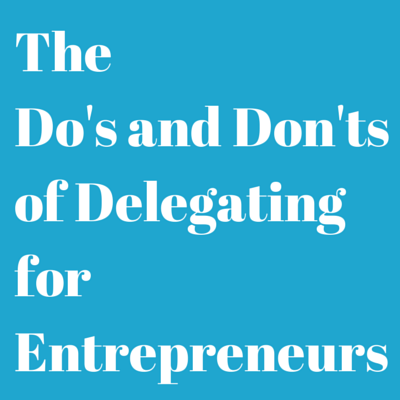

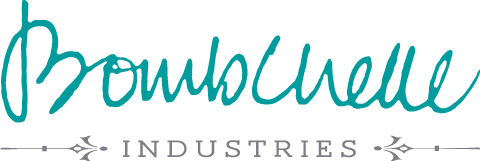

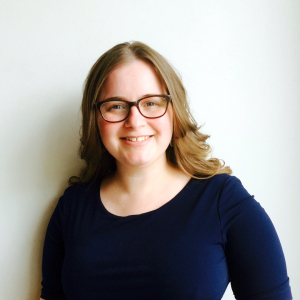 Chrissy Das edits fiction and non-fiction novels for first-time writers and award-winning published authors. She enjoys attending the theatre and running with her husband. Her fondest memories are the year she spent abroad when she met her husband and attended many Royal Shakespeare Company performances.
Chrissy Das edits fiction and non-fiction novels for first-time writers and award-winning published authors. She enjoys attending the theatre and running with her husband. Her fondest memories are the year she spent abroad when she met her husband and attended many Royal Shakespeare Company performances.